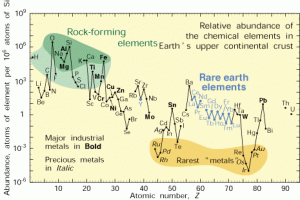What Is Rarer Than Gold?
Other than the human tendency for imitating magpies, gold really isn’t all that special
/https://tf-cmsv2-smithsonianmag-media.s3.amazonaws.com/filer/20110808091009gold_bullion_poland.jpg)
People are buying up gold faster than milk, bread and toilet paper before a Washington blizzard. The New York Times is even holding a debate on whether whole governments should be following the herd. But why gold? Other than the human tendency for imitating magpies (why else would we think the common diamond is so extraordinary?), gold really isn’t all that special. There are far more useful elements out there. And several are even rarer than gold. (I should note that the following list is limited to elements within the Earth’s crust because, let’s face it, no one is going to search any deeper than that, and asteroid mining is out of the question for now.) All of these, like gold, are noble metals, meaning that they are resistant to corrosion.
Platinum (Pt): Most familiar for its use in jewelry, platinum is more often used in the systems that control vehicle emissions in our cars. Other uses include electronics, spark plugs and in drugs to treat cancer.
Palladium (Pd): Palladium is similar to platinum in both appearance and in use; it appears in vehicle emissions equipment and electronics. It’s also a key component in fuel cells.
Ruthenium (Ru): Like platinum and palladium, ruthenium is a silvery metal that does not easily tarnish. It is used as a catalyst and to harden those other similar metals, platinum and palladium.
Rhenium (Re): The last of the naturally occurring elements to be discovered, this silvery metal is used in small amounts with nickel in jet engines. Rhenium isotopes are used to treat liver cancer.
Rhodium (Rh): Some white gold and sterling silver jewelry is plated with rhodium, which improves its appearance. It is also used in aircraft spark plugs, fountain pens and mammography systems.
Osmium (Os): The densest of natural elements—twice as dense as lead—this blue-grey metal finds a home in applications where hardness and durability are essential. Applications include surgical implants, electrical contacts and the tips of fountain pens.
Iridium (Ir): If iridium sounds familiar, that might be because there’s a group of communications satellites named after this element, a hard, brittle and dense metal. Or it could be because the K-T boundary that marks the geologic end of the dinosaurs is laced with iridium; the metal is more common in asteroids and meteorites than in the Earth’s crust. Iridium can also be found in crystals in computer memory devices, deep-water pipes, X-ray telescopes and the equipment that makes rayon fibers.
/https://tf-cmsv2-smithsonianmag-media.s3.amazonaws.com/accounts/headshot/Sarah-Zielinski-240.jpg)

/https://tf-cmsv2-smithsonianmag-media.s3.amazonaws.com/accounts/headshot/Sarah-Zielinski-240.jpg)